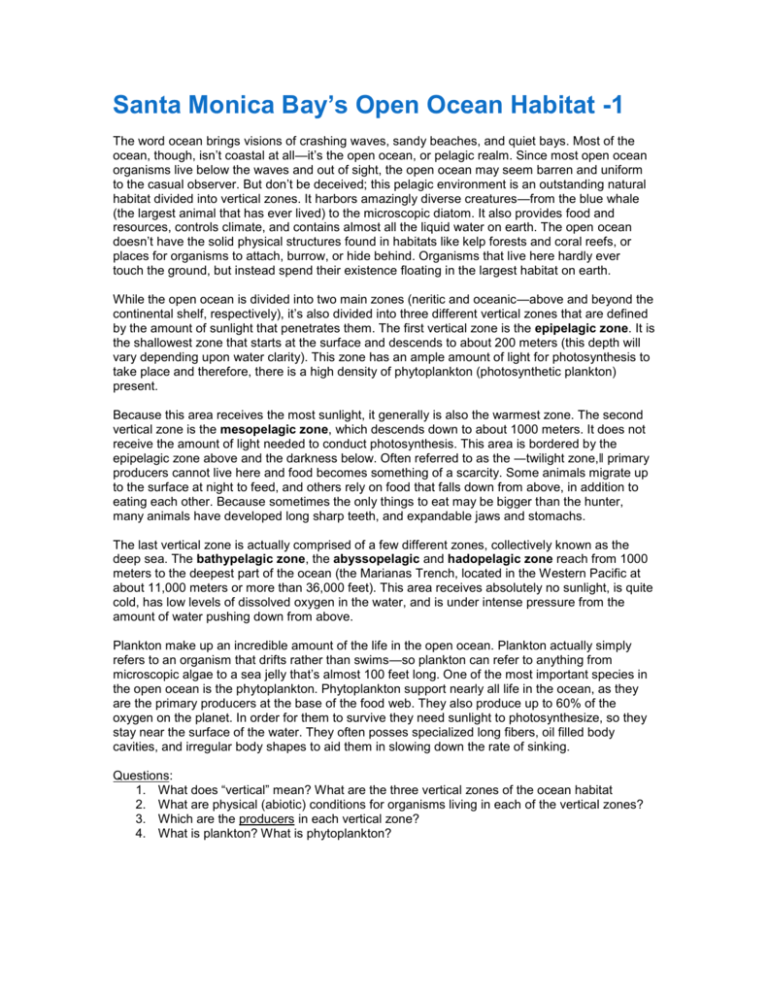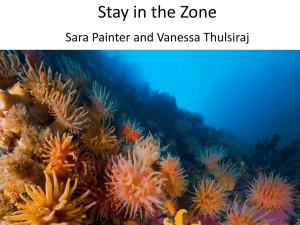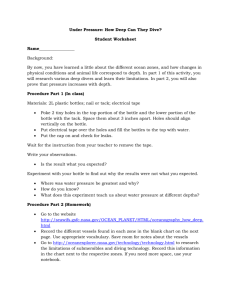Habitat - Open Ocean 1
advertisement

Santa Monica Bay’s Open Ocean Habitat -1 The word ocean brings visions of crashing waves, sandy beaches, and quiet bays. Most of the ocean, though, isn’t coastal at all—it’s the open ocean, or pelagic realm. Since most open ocean organisms live below the waves and out of sight, the open ocean may seem barren and uniform to the casual observer. But don’t be deceived; this pelagic environment is an outstanding natural habitat divided into vertical zones. It harbors amazingly diverse creatures—from the blue whale (the largest animal that has ever lived) to the microscopic diatom. It also provides food and resources, controls climate, and contains almost all the liquid water on earth. The open ocean doesn’t have the solid physical structures found in habitats like kelp forests and coral reefs, or places for organisms to attach, burrow, or hide behind. Organisms that live here hardly ever touch the ground, but instead spend their existence floating in the largest habitat on earth. While the open ocean is divided into two main zones (neritic and oceanic—above and beyond the continental shelf, respectively), it’s also divided into three different vertical zones that are defined by the amount of sunlight that penetrates them. The first vertical zone is the epipelagic zone. It is the shallowest zone that starts at the surface and descends to about 200 meters (this depth will vary depending upon water clarity). This zone has an ample amount of light for photosynthesis to take place and therefore, there is a high density of phytoplankton (photosynthetic plankton) present. Because this area receives the most sunlight, it generally is also the warmest zone. The second vertical zone is the mesopelagic zone, which descends down to about 1000 meters. It does not receive the amount of light needed to conduct photosynthesis. This area is bordered by the epipelagic zone above and the darkness below. Often referred to as the ―twilight zone,‖ primary producers cannot live here and food becomes something of a scarcity. Some animals migrate up to the surface at night to feed, and others rely on food that falls down from above, in addition to eating each other. Because sometimes the only things to eat may be bigger than the hunter, many animals have developed long sharp teeth, and expandable jaws and stomachs. The last vertical zone is actually comprised of a few different zones, collectively known as the deep sea. The bathypelagic zone, the abyssopelagic and hadopelagic zone reach from 1000 meters to the deepest part of the ocean (the Marianas Trench, located in the Western Pacific at about 11,000 meters or more than 36,000 feet). This area receives absolutely no sunlight, is quite cold, has low levels of dissolved oxygen in the water, and is under intense pressure from the amount of water pushing down from above. Plankton make up an incredible amount of the life in the open ocean. Plankton actually simply refers to an organism that drifts rather than swims—so plankton can refer to anything from microscopic algae to a sea jelly that’s almost 100 feet long. One of the most important species in the open ocean is the phytoplankton. Phytoplankton support nearly all life in the ocean, as they are the primary producers at the base of the food web. They also produce up to 60% of the oxygen on the planet. In order for them to survive they need sunlight to photosynthesize, so they stay near the surface of the water. They often posses specialized long fibers, oil filled body cavities, and irregular body shapes to aid them in slowing down the rate of sinking. Questions: 1. What does “vertical” mean? What are the three vertical zones of the ocean habitat 2. What are physical (abiotic) conditions for organisms living in each of the vertical zones? 3. Which are the producers in each vertical zone? 4. What is plankton? What is phytoplankton?










